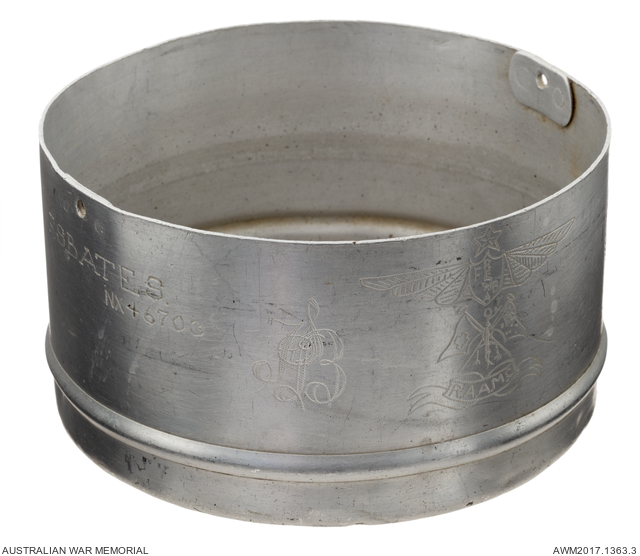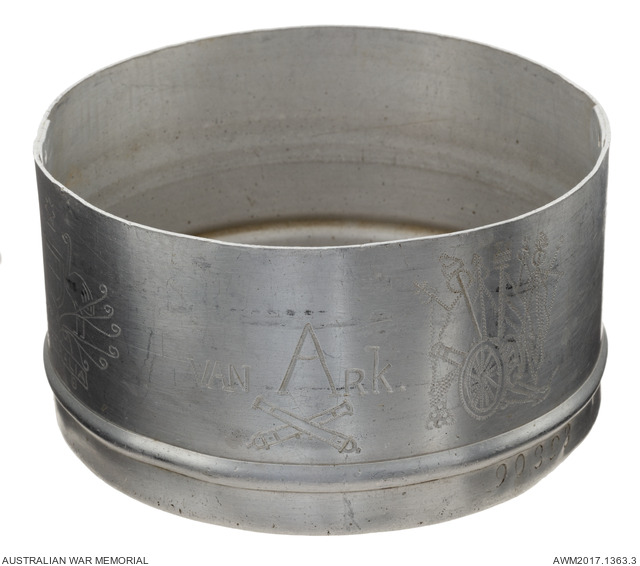| Places | |
|---|---|
| Accession Number | AWM2017.1363.3 |
| Collection type | Heraldry |
| Object type | Heraldry |
| Physical description | Aluminium |
| Maker |
van Ark, Johannes J |
| Date made | c 1941- 1945 |
| Conflict |
Second World War, 1939-1945 |
| Source credit to | This item has been digitised with funding provided by Commonwealth Government. |
Engraved Dutch army dixie: Sergeant Frederick Stanley Bates, 2/12 Field Ambulance and Sergeant Johannes J van Ark, Netherlands East Indies Army








Round aluminium dixie impressed '90898' and engraved 'VAN ARK' over crossed cannons beside a field gun set against an array of seven flags. These images all relate to Van Ark. A further set of engravings relating to Bates show 'F.S. BATES NX46703' beside ornate linked letters 'FSB'; crossed Red Cross and Australian flags above 'R.A.A.M.C.' in a scroll, with a winged shield above bearing the letters 'FRENBA' surmounted by a five-pointed star; a Rod of Asclepius within a wreath with '2ND 12TH Fld. Amb.'; and a representation of the Australian coat of arms.
Associated with the Second World War service of Frederick Stanley Bates. Born in 1902, Bates was a locomotive driver when he enlisted in the Second AIF on 15 July 1940. He was taken on strength by Australian Army Medical Corps on 13 August. Bates joined the newly formed 2/12th Field Ambulance on 22 November and was appointed acting sergeant. The unit was attached to 23rd Infantry Brigade, 8th Division and in the capacity of providing medical support for 23 Brigade the 2/12th entrained for Darwin on 12 March 1941. Promoted to sergeant on 1 July and following the beginning of the Pacific War Bates was one of about 50 men from B Company of his unit attached to Gull Force which embarked for Ambon in the Netherlands East Indies on 13 December. Arriving on the island four days later Bates was captured by the Japanese on 1 February 1942. He was officially reported missing the next day and was confirmed a prisoner of war on 17 February.
In October Bates, then held in the prison camp at Tan Toey on Ambon, was transported to Hainan Island off the coast of southern China, together with 262 Australian prisoners and 245 Dutch prisoners. This included some, but not all of the surviving members of the field ambulance and one of their doctors. On Hainan the men were housed at Hashio prison camp on Bakli Bay in three long huts, one for the Australians, one for the Dutch and one for the hospital, which was staffed by 2/12 Field Ambulance and Dutch medics. The hospital staff rarely worked outside the camp and also grew vegetables to supplement the meagre rations supplied by the Japanese.
Bates survived captivity and was liberated from the from the Bakli Bay camp in 1945 and returned to Australia aboard HMS Striker, arriving in Sydney on 9 October. He spent a period of time recovering at Concord Repatriation Hospital before being discharged on 3 January 1946 at his own request on compassionate grounds.
90898 Sergeant Johannes J van Ark of the Netherlands East Indies Army, who originally owned this dixie, was also captured on Ambon and transferred to Hainan. He, too, survived his captivity. It is assumed that the dixie was a gift to Bates, who may have swapped his own rectangular dixie, also likely to have been engraved in some way, with van Ark.